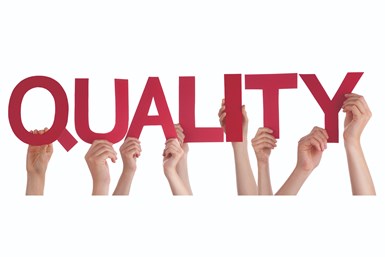Quality — A Better Definition for Manufacturing
Quality is a critical factor in manufacturing. Has the definition changed over the years?
#pmpa

What is Quality?
According to the American Society for Quality, Quality is “the totality of features and characteristics of a product or service that bear on its ability to satisfy given needs.” According to Juran, Quality is defined as “fitness for intended use.” Deming defines it as “a predictable degree of uniformity and dependability at a standard suited to the customer.” According to Phillip Crosby, “Quality is free.” All of these “classic” definitions are a way of stating that Quality is provided when “meeting or exceeding” customer expectations. This implies, however, that only the customer can determine if Quality is present. The customer is the final arbiter of Quality. But, if the customer is the one that determines Quality, then what is our role in the provision of Quality products or services? What are we to use to help us determine if we are “providing Quality?”
Conformance to Requirements is Not Enough
When I was first learning Statistical Quality Control, the definition that we were given was that Quality is “conformance to requirements.” This answer has served me well over the past 40 years in quality and management in manufacturing. By documenting and agreeing upon customer requirements, the manufacturer actually has a rational means of understanding what the customer expects as a “Quality delivery.” By having documented requirements, contract review, specifications and commercial agreements for tolerances and causes for rejection, companies were able to avoid many “nonconformances”— failures to meet requirements. The foundation of our Quality performance was dependent on our shared understanding of what exactly the customer wanted and how they would evaluate it. Documentation systems — defining all requirements and understandings in writing and covering almost every imaginable detail — was the systemic basis, the foundation for Quality in our companies. What does the customer require? Do we have it in writing? These were the bases for our production.
Featured Content
And yet our customers were still not satisfied, even when we used their preferred documentation and Quality systems. Customers did not remain with their suppliers — despite our meeting every detail of the agreed upon, well-documented, requirements. Why were they not satisfied?
There is something missing from the “conformance to requirements” definition of Quality. Let us explore what that missing piece might be. Often, when a customer chooses to find another supplier, it is not “officially” because of Quality. The products that were provided met the agreed upon, documented requirements. Typically, the customer was looking for lower price, often willing to go overseas to find comparable utility at lower price. We can argue that what we provided met the spec, but remember that the customer is the final arbiter of Quality. So what is lacking in the definition of Quality that we, as suppliers, are missing? What is there about the domain of Quality that we, as suppliers, can have true authority over, as opposed to being subject to the interpretations of our customers?
‘Quality as the Absence of Waste’
I propose that the best definition for today’s world is that “Quality is the absence of waste.” Perhaps it is the waste that is incorporated into our processes, business systems and other means of providing our deliverables to the customer that they find objectionable. For example, while all the parts that the customer received met the spec, what if, in order to do so, we had to pay a crew a half shift of overtime to inspect? The additional cost, while not passed directly to the customer, still inflates our cost of doing business and, thus, makes our offerings more expensive. The customer, because they bid out jobs, understands implicitly that our offering is inferior — because they can compare the terms and prices that others offer.
Quality is the absence of waste in process and in our human performers.
Eliminating Waste
Once we understand that Quality is the absence of waste, we can see that there are two related approaches that we can employ to eliminate waste and, thus, improve the Quality of our systems.
-
Improve Quality by curating and continuously improving our “means of production” (processes).
- Improve Quality by training and mentoring our performers so that they are operating at their highest and best use in our manufacturing processes.
Quality is the absence of waste. Our highest value resources include our performers and our processes. Continuously improving our people and processes leads to their performance at their highest and best use, and minimizes waste. This ensures Quality which our customers will recognize, and convince them to remain with us.
Why do customers look for other options from other suppliers, even when we provide them Quality? Because they intuit that there is higher Quality “out there.” Until we have eliminated all of the waste from our processes, and have our performers working at their best potential, we have not achieved Quality. We must improve our Quality by addressing continuous improvement. Every day. Every process. Every performer.
What is Quality? Your customer tells you when they look for other suppliers, that there is waste in your offerings. Your Quality is solely determined by your customer. Continuous improvement of the people and processes in your authority is the step you must take to improve your company’s Quality.
Read More Articles from PMPA:
About the Author
Miles Free III
Miles Free III is the PMPA Director of Industry Affairs with over 40 years of experience in the areas of manufacturing, quality, and steelmaking. He helps answer “How?, “With what?” and “Really?” Miles’ blog is at pmpaspeakingofprecision.com; email – mfree@pmpa.org; website – pmpa.org
RELATED CONTENT
-
Subscribe to PMPA Podcasts
"Speaking of Precision" is a podcast from Industry expert Miles Free III, in which he talks about precision machining. All episodes may be found on major platforms.
-
Rapid Methods for Determining the Weight of a Steel Bar (Imperial Units)
Counting bars in a bundle and multiplying by weight per bar allows a quick “reality check” on whether or not the tag weight is correct, or how much weight is left in the rack.
-
Recruiting for Manufacturing Part 3
Producing recruiting material can seem daunting, but you may be surprised at how many resources you already have in your shop.






